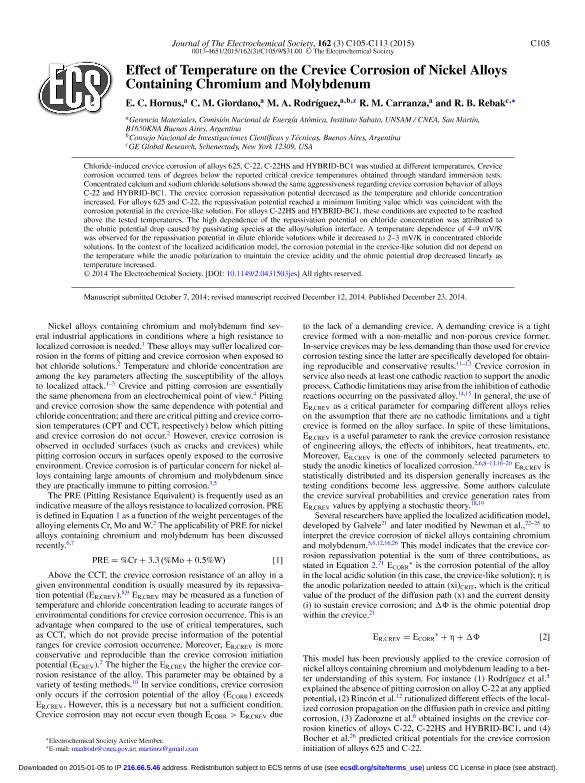Mostrar el registro sencillo del ítem
dc.contributor.author
Hornus, Edgar Cristian

dc.contributor.author
Giordano, Claudia Marcela

dc.contributor.author
Rodríguez, Martín Alejandro

dc.contributor.author
Rebak, Raul Basilio

dc.date.available
2020-03-12T19:40:52Z
dc.date.issued
2015-03
dc.identifier.citation
Hornus, Edgar Cristian; Giordano, Claudia Marcela; Rodríguez, Martín Alejandro; Rebak, Raul Basilio; Effect of temperature on the crevice corrosion of nickel alloys containing chromium and molybdenum; Electrochemical Society; Journal of the Electrochemical Society; 162; 3; 3-2015; C105-C113
dc.identifier.issn
0013-4651
dc.identifier.uri
http://hdl.handle.net/11336/99336
dc.description.abstract
Chloride-induced crevice corrosion of alloys 625, C-22, C-22HS and HYBRID-BC1 was studied at different temperatures. Crevice corrosion occurred tens of degrees below the reported critical crevice temperatures obtained through standard immersion tests. Concentrated calcium and sodium chloride solutions showed the same aggressiveness regarding crevice corrosion behavior of alloys C-22 and HYBRID-BC1. The crevice corrosion repassivation potential decreased as the temperature and chloride concentration increased. For alloys 625 and C-22, the repassivation potential reached a minimum limiting value which was coincident with the corrosion potential in the crevice-like solution. For alloys C-22HS and HYBRID-BC1, these conditions are expected to be reached above the tested temperatures. The high dependence of the repassivation potential on chloride concentration was attributed to the ohmic potential drop caused by passivating species at the alloy/solution interface. A temperature dependence of 4-9 mV/K was observed for the repassivation potential in dilute chloride solutions while it decreased to 2-3 mV/K in concentrated chloride solutions. In the context of the localized acidification model, the corrosion potential in the crevice-like solution did not depend on the temperature while the anodic polarization to maintain the crevice acidity and the ohmic potential drop decreased linearly as temperature increased.
dc.format
application/pdf
dc.language.iso
eng
dc.publisher
Electrochemical Society

dc.rights
info:eu-repo/semantics/openAccess
dc.rights.uri
https://creativecommons.org/licenses/by-nc-sa/2.5/ar/
dc.subject
CREVICE CORROSION
dc.subject
TEMPERATURE
dc.subject
NICKEL ALLOYS
dc.subject
CHLORIDE
dc.subject.classification
Ingeniería de los Materiales

dc.subject.classification
Ingeniería de los Materiales

dc.subject.classification
INGENIERÍAS Y TECNOLOGÍAS

dc.title
Effect of temperature on the crevice corrosion of nickel alloys containing chromium and molybdenum
dc.type
info:eu-repo/semantics/article
dc.type
info:ar-repo/semantics/artículo
dc.type
info:eu-repo/semantics/publishedVersion
dc.date.updated
2020-03-03T15:08:24Z
dc.journal.volume
162
dc.journal.number
3
dc.journal.pagination
C105-C113
dc.journal.pais
Estados Unidos

dc.journal.ciudad
Pennington
dc.description.fil
Fil: Hornus, Edgar Cristian. Universidad Nacional de San Martín. Instituto Sabato; Argentina. Comisión Nacional de Energía Atómica. Gerencia del Área de Energía Nuclear. Unidad de Actividad de Materiales (CAC); Argentina
dc.description.fil
Fil: Giordano, Claudia Marcela. Comisión Nacional de Energía Atómica. Gerencia del Área de Energía Nuclear. Unidad de Actividad de Materiales (CAC); Argentina. Universidad Nacional de San Martín. Instituto Sabato; Argentina. Consejo Nacional de Investigaciones Científicas y Técnicas; Argentina
dc.description.fil
Fil: Rodríguez, Martín Alejandro. Comisión Nacional de Energía Atómica. Gerencia del Área de Energía Nuclear. Unidad de Actividad de Materiales (CAC); Argentina. Consejo Nacional de Investigaciones Científicas y Técnicas; Argentina. Universidad Nacional de San Martín. Instituto Sabato; Argentina
dc.description.fil
Fil: Rebak, Raul Basilio. GE Global Research; Estados Unidos
dc.journal.title
Journal of the Electrochemical Society

dc.relation.alternativeid
info:eu-repo/semantics/altIdentifier/url/https://iopscience.iop.org/article/10.1149/2.0431503jes
dc.relation.alternativeid
info:eu-repo/semantics/altIdentifier/doi/http://dx.doi.org/10.1149/2.0431503jes
Archivos asociados
